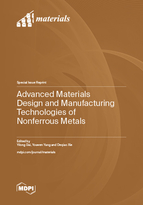Advanced Materials Design and Manufacturing Technologies of Nonferrous Metals
A special issue of Materials (ISSN 1996-1944). This special issue belongs to the section "Metals and Alloys".
Deadline for manuscript submissions: closed (20 October 2023) | Viewed by 20784
Special Issue Editors
Interests: processing of metal; medical metals; corrosion behavior; biocompatibility; metal–air batteries
Special Issues, Collections and Topics in MDPI journals
Interests: additive manufacturing; biomedical metals; degradation behavior; porous structure
Special Issues, Collections and Topics in MDPI journals
Interests: additive manufacturing; distortion; residual stress; high strength; pore defect
Special Issues, Collections and Topics in MDPI journals
Special Issue Information
Dear Colleagues,
Although the consumption of non-ferrous metal materials (Mg, Al, Zn, Ti, Cu, Ni, etc.) only accounts for 5% of the total consumption of metal materials, they play an important role in engineering because of their excellent electrical and thermal conductivity, small relative density, stable chemical properties, heat resistance and corrosion resistance. Recently, advanced materials design and manufacturing technologies have been developed, for example, machine learning, CALPHAD methods, high throughput computing, additive manufacturing, semi-solid processing, etc. This Special Issue focuses on the development of advanced materials design and manufacturing technologies which has opened up a new way for the application of non-ferrous metals in structural and functional materials.
It is my great pleasure to invite everyone to submit a manuscript for this Special Issue. Full papers, communications, or reviews on advanced materials design and manufacturing technologies of nonferrous metals are all welcome.
Dr. Yilong Dai
Dr. Youwen Yang
Dr. Deqiao Xie
Guest Editors
Manuscript Submission Information
Manuscripts should be submitted online at www.mdpi.com by registering and logging in to this website. Once you are registered, click here to go to the submission form. Manuscripts can be submitted until the deadline. All submissions that pass pre-check are peer-reviewed. Accepted papers will be published continuously in the journal (as soon as accepted) and will be listed together on the special issue website. Research articles, review articles as well as short communications are invited. For planned papers, a title and short abstract (about 100 words) can be sent to the Editorial Office for announcement on this website.
Submitted manuscripts should not have been published previously, nor be under consideration for publication elsewhere (except conference proceedings papers). All manuscripts are thoroughly refereed through a single-blind peer-review process. A guide for authors and other relevant information for submission of manuscripts is available on the Instructions for Authors page. Materials is an international peer-reviewed open access semimonthly journal published by MDPI.
Please visit the Instructions for Authors page before submitting a manuscript. The Article Processing Charge (APC) for publication in this open access journal is 2600 CHF (Swiss Francs). Submitted papers should be well formatted and use good English. Authors may use MDPI's English editing service prior to publication or during author revisions.
Keywords
- materials design
- advanced manufacturing technologies
- medical metals
- nonferrous metals
- additive manufacturing









